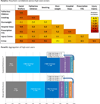Childhood forecasting of a small segment of the population with large economic burden
- PMID: 28706997
- PMCID: PMC5505663
- DOI: 10.1038/s41562-016-0005
Childhood forecasting of a small segment of the population with large economic burden
Abstract
Policy-makers are interested in early-years interventions to ameliorate childhood risks. They hope for improved adult outcomes in the long run, bringing return on investment. How much return can be expected depends, partly, on how strongly childhood risks forecast adult outcomes. But there is disagreement about whether childhood determines adulthood. We integrated multiple nationwide administrative databases and electronic medical records with the four-decade Dunedin birth-cohort study to test child-to-adult prediction in a different way, by using a population-segmentation approach. A segment comprising one-fifth of the cohort accounted for 36% of the cohort's injury insurance-claims; 40% of excess obese-kilograms; 54% of cigarettes smoked; 57% of hospital nights; 66% of welfare benefits; 77% of fatherless childrearing; 78% of prescription fills; and 81% of criminal convictions. Childhood risks, including poor age-three brain health, predicted this segment with large effect sizes. Early-years interventions effective with this population segment could yield very large returns on investment.
Figures








Similar articles
-
Return On Investment From Childhood Immunization In Low- And Middle-Income Countries, 2011-20.Health Aff (Millwood). 2016 Feb;35(2):199-207. doi: 10.1377/hlthaff.2015.1086. Health Aff (Millwood). 2016. PMID: 26858370
-
Lifetime earnings patterns, the distribution of future Social Security benefits, and the impact of pension reform.Soc Secur Bull. 2000;63(4):74-98. Soc Secur Bull. 2000. PMID: 11641991
-
A simulation of affordability and effectiveness of childhood obesity interventions.Acad Pediatr. 2011 Jul-Aug;11(4):342-50. doi: 10.1016/j.acap.2011.04.005. Acad Pediatr. 2011. PMID: 21764018
-
Early childhood health promotion and its life course health consequences.Acad Pediatr. 2009 May-Jun;9(3):142-149.e1-71. doi: 10.1016/j.acap.2008.12.007. Acad Pediatr. 2009. PMID: 19450773 Review.
-
Changing factors and changing needs in women's health care.Nurs Clin North Am. 1986 Mar;21(1):111-23. Nurs Clin North Am. 1986. PMID: 3513129 Review.
Cited by
-
The Dissociation between Adult Intelligence and Personality with Respect to Maltreatment Episodes and Externalizing Behaviors Occurring in Childhood.J Intell. 2018 Jul 9;6(3):31. doi: 10.3390/jintelligence6030031. J Intell. 2018. PMID: 31162458 Free PMC article.
-
Life history trade-offs associated with exposure to low maternal capital are different in sons compared to daughters: Evidence from a prospective Brazilian birth cohort.Front Public Health. 2022 Sep 20;10:914965. doi: 10.3389/fpubh.2022.914965. eCollection 2022. Front Public Health. 2022. PMID: 36203666 Free PMC article.
-
Adolescent depression, early psychiatric comorbidities, and adulthood welfare burden: a 25-year longitudinal cohort study.Soc Psychiatry Psychiatr Epidemiol. 2021 Nov;56(11):1993-2004. doi: 10.1007/s00127-021-02056-2. Epub 2021 Mar 14. Soc Psychiatry Psychiatr Epidemiol. 2021. PMID: 33715045 Free PMC article.
-
Genomics, Big Data, and Broad Consent: a New Ethics Frontier for Prevention Science.Prev Sci. 2018 Oct;19(7):871-879. doi: 10.1007/s11121-018-0944-z. Prev Sci. 2018. PMID: 30145751 Free PMC article.
-
Could Physical Fitness Be Considered as a Protective Social Factor Associated with Bridging the Cognitive Gap Related to School Vulnerability in Adolescents? The Cogni-Action Project.Int J Environ Res Public Health. 2021 Sep 25;18(19):10073. doi: 10.3390/ijerph181910073. Int J Environ Res Public Health. 2021. PMID: 34639375 Free PMC article.
References
-
- Almond D, Currie J. Human capital development before age five. 2010 < http://www.nber.org/papers/w15827>.
Grants and funding
LinkOut - more resources
Full Text Sources
Other Literature Sources
